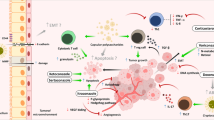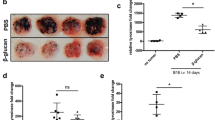Abstract
Candida albicans infections are very frequent in cancer patients, whose immune system is often compromised, but whether this fungal pathogen affects cancer progression is unknown. C. albicans infection involves endogenous production of inflammatory cytokines such as tumour necrosis factor alpha (TNF-α) and interleukin-18 (IL-18). Increased levels of these cytokines have already been correlated with metastasis of most common cancer types. In this study, a well-established model of IL-18-dependent hepatic melanoma metastasis was used to study whether C. albicans can alter the ability of murine B16 melanoma (B16M) cells to colonize the liver. First, we determined the ability of intrasplenically (IS) injected B16M cells to metastasize into the liver of mice challenged with 5 × 104C. albicans cells by three different routes (intravenous, IV; intrasplenic, IS; or intraperitoneal, IP) 12 h prior to injection of B16M cells. We demonstrated that C. albicans significantly increased metastasis of B16M cells with all three fungal injection routes. Pro-metastatic effects occurred when hepatic colonization with B16M cells place after the peak of TNF-α and IL-18 levels had been reached in the hepatic blood of fungal challenged mice. In a second set of experiments, mice were fungal challenged 4 days after injection of B16M cells. In these mice, C. albicans also potentiated the growth of established micro-metastases. Significantly, the fungal challenge had pro-metastatic effects without the C. albicans being able to reach the liver, suggesting that soluble factors can promote metastasis in remote sites. Mouse treatment with antifungal ketoconazol abrogated hepatic TNF-α stimulation by C. albicans and prevented the enhancement of hepatic metastasis in fungal challenged-mice. Therefore, the pro-inflammatory microenvironment generated by the host’s systemic response to C. albicans stimulates circulating cancer cells to metastasize in the liver.







Similar content being viewed by others
References
Herrera LA, Benítez-Bribiesca L, Mohar A et al (2005) Role of infectious diseases in human carcinogenesis. Environ Mol Mutagen 45(2–3):284–303
Parkin DM (2006) The global health burden infection-associated cancers in year 2002. Int J Cancer 118(12):3030–3044
Anasagasti MJ, Olaso E, Calvo F, Mendoza L et al (1997) Interleukin 1-dependent and -independent mouse melanoma metastases. J Natl Cancer Inst 89(9):645–651
Chirivi RG, Garofalo A, Padura IM et al (1993) Interleukin 1 receptor antagonist inhibits the augmentation of metastasis induced by interleukin 1 or lipopolysaccharide in a human melanoma/nude mouse system. Cancer Res 53(20):5051–5054
Rodriguez-Cuesta J, Vidal-Vanaclocha F, Mendoza L et al (2005) Effect of asymptomatic natural infections due to common mouse pathogens on the metastatic progression of B16 murine melanoma in C57BL/6 mice. Clin Exp Metastasis 22(7):549–558
DiNubile MJ, Hille D, Sable CA, Kartsonis NA (2005) Invasive candidiasis in cancer patients: observations from a randomized clinical trial. J Infect 50:443–449
Fradin C, Hube B (2006) Transcriptional profiling of Candida albicans in human blood. Microbe 1(2):76–80
Pagano L, Caira M, Candoni A et al (2006) The epidemiology of fungal infections in patients with hematologic malignancies: the SEIFEM-2004 study. Hematologica 91(8):1068–1075
Bodey GP, Mardani M, Hanna HA et al (2002) The epidemiology of Candida glabrata and Candida albicans fungemia in immunocompromised patients with cancer. Am J Med 112(5):380–385
Stuyt RJ, Netea MG, Verschueren I et al (2002) Role of interleukin-18 in host defense against disseminated Candida albicans infection. Infect Immun 70(6):3284–3286
Netea MG, Vonk AG, van den Hoven M et al (2003) Differential role of IL-18 and IL-12 in the host defense against disseminated Candida albicans infection. Eur J Immunol 33(12):3409–3417
Vidal-Vanaclocha F, Mendoza L, Telleria N et al (2006) Clinical and experimental approaches to the pathophysiology of interleukin-18 in cancer progression. Cancer Metastasis Rev 25(3):417–434
Dinarello CA (2006) The paradox of pro-inflammatory cytokines in cancer. Cancer Metastasis Rev 25(3):307–313
Barea PL, Calvo E, Rodriguez JA et al (1999) Characterization of Candida albicans antigenic determinants by two-dimensional polyacrilamide gel electrophoresis and enhanced chemiluminiscence. FEMS Immunol Med Microbiol 23(4):343–354
Vidal-Vanaclocha F, Amezaga C, Asumendi A et al (1994) Interleukin-1 receptor blockade reduces the number and size of murine B16 melanoma hepatic metastases. Cancer Res 54(10):2667–2672
Mendoza L, Carrascal T, De Luca M et al (2001) Hydrogen peroxide mediates vascular cell adhesion molecule-1 expression from interleukin-18-activated hepatic sinusoidal endothelium: implications for circulating cancer cell arrest in the murine liver. Hepatology 34(2):298–310
Vidal-Vanaclocha F, Fantuzzi G, Mendoza L et al (2000) IL-18 regulates IL-1beta-dependent hepatic melanoma metastasis via vascular cell adhesion molecule-1. Proc Natl Acad Sci USA 97(2):734–739
Carrascal MT, Mendoza L, Valcarcel M et al (2003) Interleukin-18 binding protein reduces B16 melanoma hepatic metastasis by neutralizing adhesiveness and growth factors of sinusoidal endothelium. Cancer Res 63(2):491–497
Mehlen P, Puisieux A (2006) Metastasis: a question of life or death. Nat Rev 6:449–457
Weiss L (1990) Metastatic inefficiency. Adv Cancer Res 54:159–211
Schreurs J (1993) Cytokines in infectious disease: the battle between host and pathogen. Curr Opin Biotechnol 4(6):727–733
Orozco AS, Zhou X, Filler SG (2000) Mechanisms of the proinflammatory response of endothelial cells to Candida albicans infection. Infect Inmmun (68):1134–1141
Ramirez A, Gallot N, Abad A et al. (2004) Variations in B16 melanoma cell adhesion to the mouse hepatic sinusoidal endothelium (HSE) and cytokines production were induced by different Candida albicans strains. In: Paper presented at the 12th international symposium on cells of the hepatic sinusoid, Bilbao, 5–9 Sep 2004
Werling D, Jungi TW (2003) TOLL-like receptors linking innate and adaptive immune response. Vet Immunol Immunopathol 91(1):1–12
Roeder A, Kirschning CJ, Rupec RA et al (2004) Toll-like receptors as key mediators in innate antifungal immunity. Med Mycol 42(6):485–498
Arteta B, Lasuen N, Vidal-Vanaclocha F (2007) Tumor-activated endothelial cells inhibit anti-tumor immunity during hepatic colon carcinoma metastasis via mannose receptor upregulation. In: Paper presented at the 4th international conference on tumor microenvironment: progression, Florence, 6–10 Mar 2007
Acknowledgments
This work was supported by grants from the Carlos III National Institute of Health (FIS program, no. PI031727), from the CICYT (no. SAF2006-09341) and from Basque Country University to consolidated research groups (no. UPV13641/2003 and GIU06/07) to Fernando Vidal-Vanaclocha and to Fernando L. Hernando (no. UE03/A04 and UE08/14). We acknowledge Dr. David Gubb for critical reading of the manuscript.
Author information
Authors and Affiliations
Corresponding authors
Additional information
Guillermo Martínez-de-Tejada and Fernando Vidal-Vanaclocha share senior authorship.
Rights and permissions
About this article
Cite this article
Rodríguez-Cuesta, J., Hernando, F.L., Mendoza, L. et al. Candida albicans enhances experimental hepatic melanoma metastasis. Clin Exp Metastasis 27, 35–42 (2010). https://doi.org/10.1007/s10585-009-9300-9
Received:
Accepted:
Published:
Issue Date:
DOI: https://doi.org/10.1007/s10585-009-9300-9




